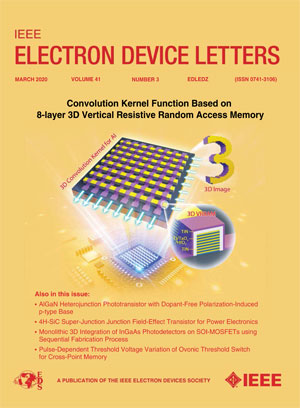高温下 Hf₀.₅Zr₀.₅O₂ 电容器中残余极化的波动效应
IF 4.1
2区 工程技术
Q2 ENGINEERING, ELECTRICAL & ELECTRONIC
引用次数: 0
摘要
研究基于铪的铁电(FE)器件在不同温度下的极化行为和失效机制对于提高 FE 存储器在实际工作条件下的可靠性至关重要。在本研究中,我们研究了高温下 Hf $_{{0}.{5}}$ Zr $_{{0}.{5}}$ O2 (HZO) 电容器在电循环过程中的残余极化(Pr)波动。Pr值的降低可归因于四方(T-)相界面层的形成和增厚,从而降低了施加到正方(O-)相层的电场。随后,T 相界面层中的氧缺陷和漏电流导致 Pr 值增加,从而提高了施加到 O-FE 层的电场。因此,施加到 O-FE 层的电场波动被认为是 Pr 波动的主要原因。我们对 T 层、缺陷和电特性的直接表征为评估萤石型 FE 材料的 FE 相稳定性和氧缺陷演化提供了见解,为提高器件可靠性的策略提供了指导。本文章由计算机程序翻译,如有差异,请以英文原文为准。
The Fluctuation Effect of Remnant Polarization in Hf₀.₅Zr₀.₅O₂ Capacitors at Elevated Temperatures
Studying the ferroelectric (FE) polarization behavior and failure mechanism of hafnia-based FE devices at varying temperatures is essential for enhancing the reliability of FE memory under real-working conditions. In this study, we investigated the remnant polarization (Pr) fluctuation during electrical cycling in Hf
$_{{0}.{5}}$
Zr
$_{{0}.{5}}$
O
2
(HZO) capacitors at elevated temperatures. The decrease in Pr can be attributed to the formation and thickening of the tetragonal (T-) phase interface layer, which reduces the electric field applied to the orthorhombic (O-) phase layer. The subsequent increase in Pr is caused by oxygen defects and leakage current in the T-phase interface layer, raising the electric field applied to the O-FE layer. Therefore, fluctuations in the electric field applied to the O-FE layer are considered as the primary cause for Pr fluctuation. Our direct characterization of T-layers, defects, and electrical properties offers insights into assessing FE phase stability and oxygen defect evolution in fluorite-type FE materials, guiding strategies to enhance device reliability.
求助全文
通过发布文献求助,成功后即可免费获取论文全文。
去求助
来源期刊

IEEE Electron Device Letters
工程技术-工程:电子与电气
CiteScore
8.20
自引率
10.20%
发文量
551
审稿时长
1.4 months
期刊介绍:
IEEE Electron Device Letters publishes original and significant contributions relating to the theory, modeling, design, performance and reliability of electron and ion integrated circuit devices and interconnects, involving insulators, metals, organic materials, micro-plasmas, semiconductors, quantum-effect structures, vacuum devices, and emerging materials with applications in bioelectronics, biomedical electronics, computation, communications, displays, microelectromechanics, imaging, micro-actuators, nanoelectronics, optoelectronics, photovoltaics, power ICs and micro-sensors.
 求助内容:
求助内容: 应助结果提醒方式:
应助结果提醒方式:


